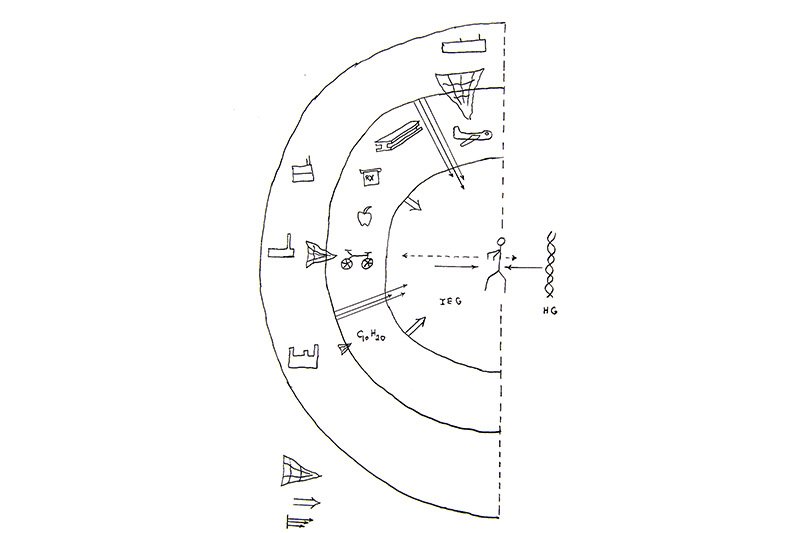Mapping the Other Genome

Above: Overcash sketched this drawing in 2001 to represent his idea of the environmental genome. The rationale to even look for its shape is addressed in two paragraphs of his paper, “Environmental Genome of Industrial Products: The Missing Link for Human Health,” published in the Royal Society of Chemistry’s Green Chemistry journal. Learn more at www.environmentalgenome.org
CSE alumnus seeks to improve the use of industrial chemicals through his devised mapping method
December 4, 2019
Quick, what do computers, ping pong balls, highways, yoga mats, and ocean liners have in common? And virtually every other product currently in use in the world?
They’re all made from the same central group of 100,000 industrial chemicals.
And since 2016, Michael Overcash (Chemical Engineering Ph.D. ’72) and his researchers have focused on mapping these chemicals—the essential building blocks of everything humans have created and engineered. It’s part of an effort called the Environmental Genome Initiative (EGI), a nonprofit that seeks to better understand the chemicals in use today.
The EGI grew out of earlier research that Overcash and his team did, which led to the discovery and publication of a repeating pyramidal structure across chemicals in commerce. Their discovery mirrored the finding made in 1951 that the human genome has a pattern—the double helix.
“Seeing the repeating elements—the shape, a base of a certain width, a certain distance to the top—allowed us to put the pieces together,” stated Overcash.
“It became an organizing principle for how to assemble the data,” he said.
Their goals are to create an organized chemical description of the entire chemical industry globally and define the manufacturing improvement and environmental footprints of each of the 100,000 chemicals—a data effort never before envisioned.
Upon completion, it will serve as an open-source database for industry, academia, public policy users, and others.
And just as the human genome provided a genetic blueprint that continues to advance human health, it’s anticipated that the EGI will support critical discoveries in chemical manufacturing, public health, national security, and other areas.
2,000 and counting...
Overcash, a professor of chemical engineering who has taught at academic and research institutions in the United States and abroad, has long been at the forefront of research and development related to the environment, manufacturing, and systems analysis.
While doing his doctoral work at the University of Minnesota—a school he chose because of its highly regarded graduate programs—Ken Keller, former University of Minnesota president, was his advisor. In recent years, Keller participated in a conference to discuss the potential of the EGI.
What prompted Overcash to fully commit to the EGI was the epidemiology recognition that 70 to 90 percent of all global chronic diseases come from the environment. In the United States alone, 40 million to 60 million people have chronic diseases.
“In all probability, those diseases may stem from a causative factor in the environment, of which pollutants are significant,” he said.
One study currently under discussion in the EGI and the National Institutes of Health is how pollution exposure impacts maternal and fetal health, which could yield meaningful insights.
To date, about 2,000 chemicals have been mapped.
Overcash anticipates needing another five or six years to complete all 100,000 chemicals. He’s currently working to establish funding support for additional mapping teams in the United States and around the world.
“Ultimately, we have no idea how the EGI will be used,” he said. “But its potential for global society and human health is important.”
Written by Jodi Auvin
Read about CSE alumnus Collin Smith's job as a natural-area restoration designer in "Designing Greener Spaces."
Read about CSE alumna Stella Mandago job working as an energy advisor for African Development Bank in "Empowering Africa."
